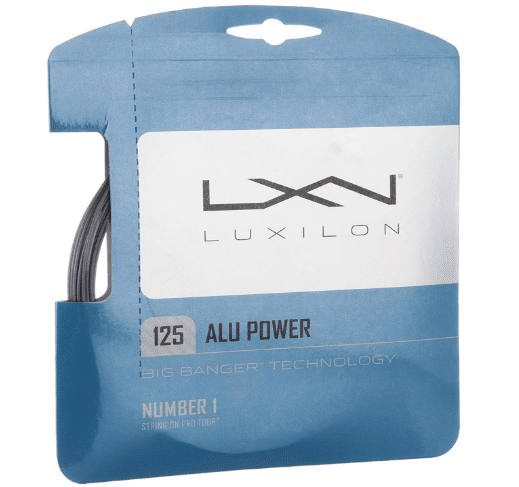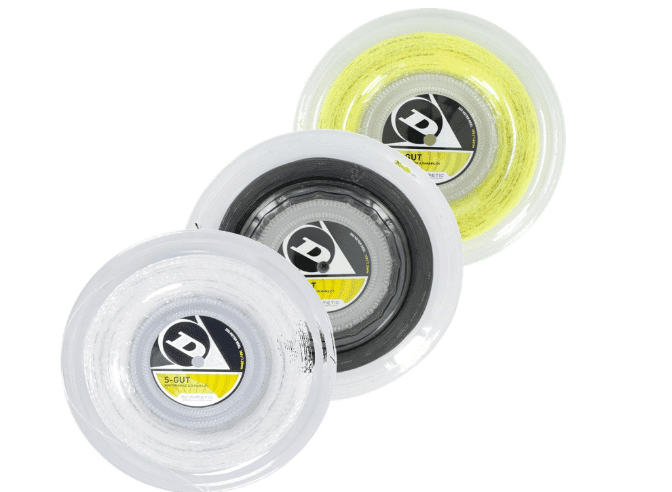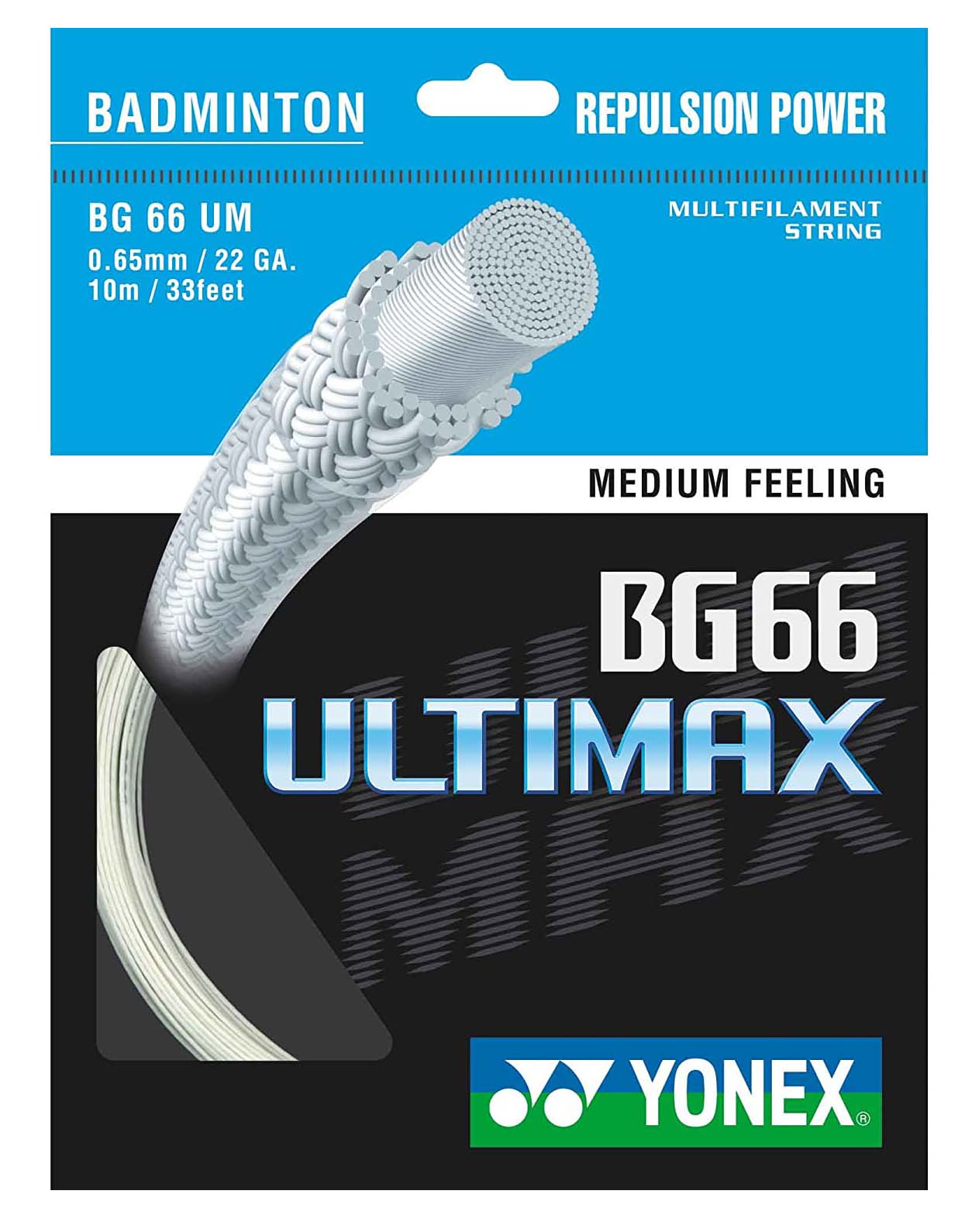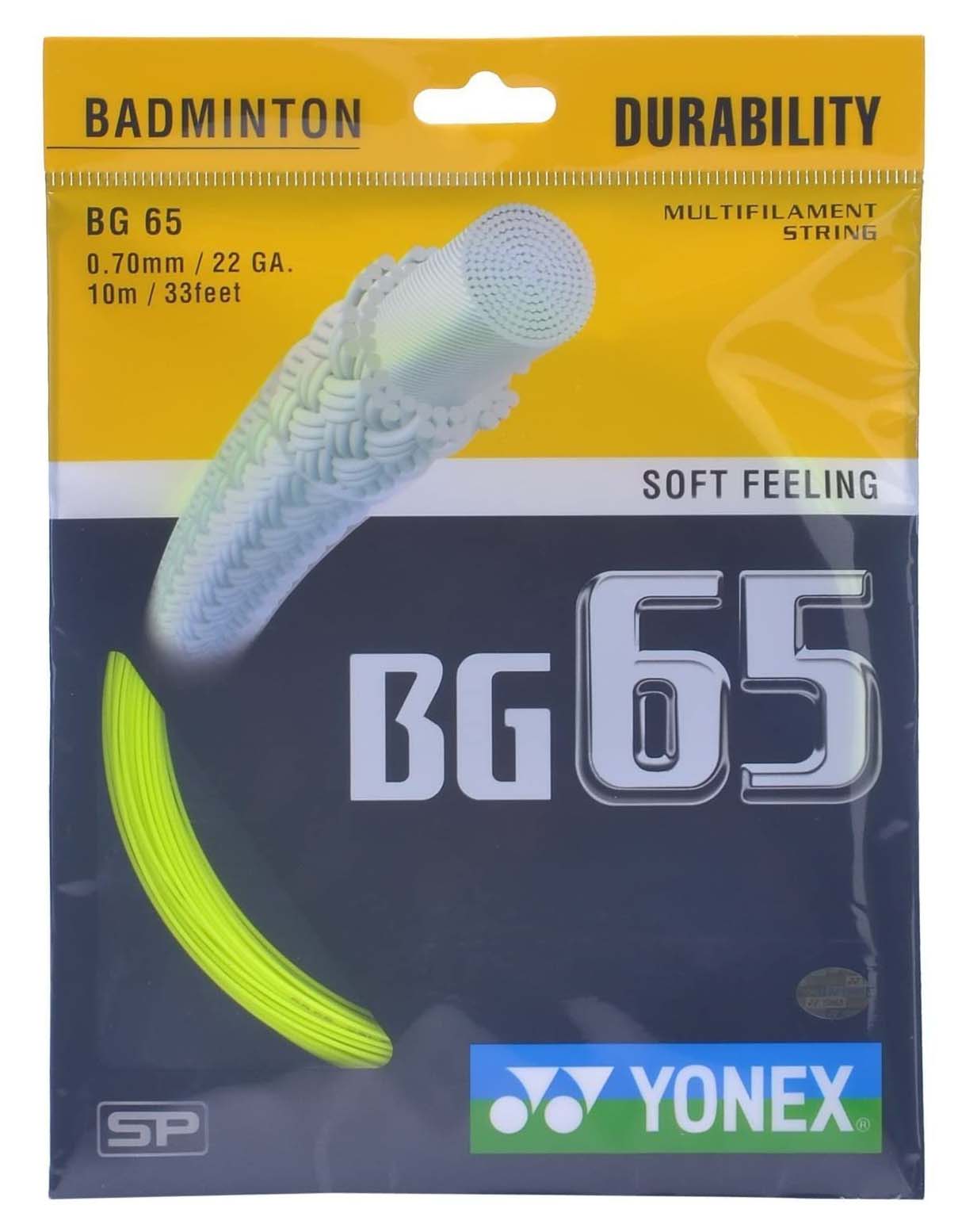Are you seeking the best badminton string for smashing? If so, then you are at the right place. In this article, we will explore the five best badminton strings for smash and control.
String influences a lot on your gaming, especially when you wish to strike harder. Also, we regularly see badminton racket strings break after hard play, so keeping an extra string would be handy.
Best Badminton String For Smashing
Image | Name | Key Feature | Ratings | Price |
|---|---|---|---|---|
| ||||
| ||||
| ||||
| ||||
|
Which are the best badminton string for smashing?
It's not an easy task to find out the correct string for your racket. You can be fooled by exaggerated marketing. To save you, we have done the research work for you and present you with the best badminton string for smash. Let's check it out.
The Yonex BG66 Ultimax is a high-intensity multifilament string. It offers excellent repellency and exceptional speed while ensuring a high level of control.
Despite its thin gauge of only 0.65mm, this string is very durable. This is also one of the reasons for its success with the best players in the world.
Indeed, its high-density nylon core is 30% more resistant than a conventional nylon string. It also helps to compensate for the lack of power without sacrificing control.
This Yonex BG66 Ultimax string is available here in a single racquet version and yellow color.
Some specifications:
- String type: multifilament
- Gauge: 0.65mm
- Length: 10m
The Nanogy 99 is one of the best badminton strings for smashing that offer the most control. It facilitates net spins and slices but also provides excellent power.
This slightly grainy rope consists of braided fiber with a special nylon coating. It guarantees optimum grip of the steering wheel for high efficiency in spins and slices.
Its 0.69mm gauge makes it more robust than the BG98, but it is as efficient as the latter. This string is recommended for players who want control without sacrificing power.
Some specifications:
- String type: multifilament
- Gauge: 0.69mm
- Length: 10m
The Yonex BG80 is also a multifilament string but with a gauge of 0.68mm. It consists of a core with several fibers surrounded by a Vectran sheath.
This string used by several professional players gives a high speed at the wheel thanks to optimal energy restitution. It guarantees exceptional control, excellent precision, and excellent power.
This string is also recommended for experienced players who appreciate potent strikes. It is also sold here in its 10m version in yellow color for a single racket.
Some specifications:
- String type: multifilament
- Gauge: 0.68mm
- Length: 10m
The Yonex BG65 is a 0.70mm gauge string. It is a multi-filament model offering an excellent compromise between performance and durability.
Its excellent tension resistance distinguishes this string. It is versatile therefore suitable for any player, whether beginner, intermediate, or experienced.
The Yonex BG65 is often recommended for players who are unsure which string is suitable for them. It is offered here in its version for a racket but also exists in a 200m reel.
Some specifications:
- String type: multifilament
- Gauge: 0.70mm
- Length: 10m
The Nanogy 98 is a string for attackers. Its thin gauge of only 0.66mm makes it very powerful.
This multifilament string is made of nylon covered with a carbon nanotube cup-stack. It guarantees maximum elasticity and offers excellent repellency.
The thinness of the string facilitates the penetration of the air and thus makes it possible to increase the speed of the strike. It also supports high voltages.
Some specifications:
- String type: multifilament
- Gauge: 0.66mm
- Length: 200m
- Color: cosmic gold
What is badminton string?
First of all, it should be clarified what a badminton string is. A badminton string is a thin thread that the badminton racket is strung with.
Different diameters and materials are available. The standard rope is made of nylon and has a diameter of 0.62-0.8mm. Other materials may have been added to nylon to achieve better hardness or durability.
Titanium is often used for this. The stringing of the racquet is variable in terms of stringing strength and must, among other things, be adapted to the taste of the respective player.
What are the special features of badminton strings for smash?
Choosing the best badminton string for smashing is essential. Each well-known manufacturer offers 10-20 strings with different weaknesses and strengths. They all differ in their springiness, aerodynamic properties, cushioning, and ball control when hitting the shuttle.
Such fine-tuning is not so crucial for amateur players, especially since the prices for badminton strings can sometimes be very high. As an amateur player, therefore, you can concentrate on the thickness of the badminton string already indicated.
Beginners should generally choose a medium thickness, around 0.7mm. It represents a compromise between durability and precision when typing. The thicker the side, the faster the ball will be. However, the shot also becomes less precise.
Professionals, on the other hand, should choose ropes that are less than 0.7mm. 0.62mm would be ideal. It allows you to hit the ball more precisely.
The only downside is the durability. This decreases quickly with a thinner string. In addition to pure nylon threads, there are, as already mentioned, staggered ropes. If titanium has been added to a nylon rope, titanium provides more stability in the string. The result is longer shelf life.
What should you watch out for when stringing?
You should check on the thread regularly. Noticeable deterioration can occur after just a few months. The thickness of the coating is given in kilograms.
Similar to string thickness, the thicker the string, the more force is transmitted and the less accurately the ball is hit. If you choose a smaller string, the ball flies slower and is easier to control.
This last variant is particularly suitable for professionals, as they can compensate for the lack of speed with the strength in their arms and the technique they have learned.
Accordingly, beginners choose a 5-7 kg thickness, and professionals a force of 10-13 kg. Advanced players choose the medium range as their tensile strength.
Type of badminton strings for smashing
Since synthetics burst into the string industry, attempts have been made to mimic the properties of the natural casing through different combinations. Today we could classify the strings between:
Natural gut strings
They are made with the intestine of cows or sheep. As mentioned, these are the strings that offer the most control and power, although they last little compared to the monofilament.
Nylon ropes assembled
These are strings made up of a solid core surrounded by layers of multifilament. The more layers you have, the better the quality of the rope.
They are cheaper than monofilaments and last longer, although they do not offer the same benefits. If your wallet suffers, choose this type of chain.
Monofilament cords (Polyester-Kevlar)
Ropes are formed from a single filament of resistant material. Although initially made to provide durability for revolutionary players, monofilament strings are almost as powerful and responsive as multifilaments so that we can speak of high-end monofilaments.
Their main characteristic is durability, although they don't initially offer as good a feel and power as the multifilament or the casing.
Multifilament chains
They are made up of hundreds of intertwined micro-filaments. They are the closest to natural casings, without being as expensive as that, and offer good performance in terms of control and power. In turn, they are not as durable.
Hybrid strings (mono-filament + multi-filament)
It is a mixed string (monofilament in horizontal lines and multifilament in vertical strings, seeking a balance between durability and feel. Many professional players widely use them.
In addition, it should be remembered that the tension and thickness of courage influence the control and power sought, the thinnest strings being those that offer the most control and power and the thickest those that last the longest.
The higher the voltage, the more control will be obtained, but the power will be lost. In short, I advise each player to find the ideal combination of string, thickness, and tension.
String tension
The tension of each racquet depends on each player. This is measured in kilograms or pounds, and the difference between one low tension and another allows the racquet to have better or worse control or pull the shuttle slower or faster when hitting it.
The lower voltages provide more strength and less control, making them ideal for lower-level players who need extra help pushing the shuttle to the other field.
While as the player's level increases, he will be able to use higher tensions since his technique and training allow him to hit the racquet harder without assistance, and what he needs is more control than control.
- Tension for advanced players: 11-15 kg
- Tension for intermediate players: 8.5 - 11 kg
- Tension for amateurs: less than 8 kg.
According to the French badminton federation, "The more a string is stretched, the more it stiffens, eliminating its elasticity and therefore its power, but it increases precision. The less a line is extended, the more it restores potency to the detriment of accuracy.
The importance of badminton stringing is no longer proven because it brings different sensations from one diameter to another.
So choose the best badminton string that will have a significant impact on your game and performance.
When and why should you change badminton strings?
The right time to restring a badminton racket depends on a number of criteria:
- frequency of use,
- the chosen string,
- the style of play,
- voltage.
It is therefore difficult to say with precision when the strings of a badminton racket will need to be replaced.
The frequency of play
The more you play, the more the strings of your badminton racket will wear. You will see the wear marks on the crossing of the upright and the cross beamlines. This already gives you some idea of when to replace them and which badminton string to choose.
A quality rope
Choosing the best badminton string is essential to benefit from increased longevity. Its composition and its thickness are decisive. A badminton brand like Yonex, for example, is an accurate benchmark. Do not hesitate to make a badminton string comparison to get an idea of the quality level of each product.
The style of play
If you are used to touching hits, your string frequencies will be more widely spaced. If you hit hard a lot, your badminton string will last less.
Voltage
Broken badminton string occurs quickly when the tension is too high. It is, therefore, an equally decisive criterion. With strings too tight, you will send your badminton racket for repair much sooner than expected.
How to choose the best badminton racket string for smashing?
Whether you are a beginner or an experienced player, the choice of a badminton string is essential. Not only will you have a good feeling but you can do whatever you want with the wheel. Comparing and testing as many badminton strings as possible should help you identify which model is suitable for you.
The ideal thickness of badminton string
Buying the best badminton racket takes a little thought. The badminton brands like Carlton and Yonex often
highlight the thickness or gauge of the rope. This will both determine:
- durability,
- and gaming sensations.
Badminton string thickness generally varies from 0.61mm to 0.75mm.
- Large diameter makes the string resistant to the detriment of precision and feel.
- The latter improve considerably with a thin badminton string, but it will be more fragile on the other hand.
For financial reasons, you will probably tend to go for a larger caliber that offers better longevity. Be aware, however, that the elasticity of the rope and its repellency decreases over time and with use.
You must therefore change the string regularly to regain optimal playing comfort. This may take a toll on your budget in the long run, even if the rope is inexpensive.
The choice of string
For casual gamers
If you play infrequently, then the thrills may not be a priority. Choose a hardwearing string. We, therefore, recommend a thick diameter of around 0.70mm or even 0.71mm. A monofilament string that stands out for its durability is sufficient.
For regular players
If you play more frequently, then you will be pickier about the sensations. You'll also want a string that lasts. Choose a multifilament rope that offers a good compromise between feel and durability. A hybrid badminton string would be even better. Its thicker uprights promote longer life while its thinner cross members ensure improved control.
For professional athletes
If you are a professional player, then you will be playing very often. Playability, control, and precision will be imperative for you. In this case, we recommend a fine grooved string less than 0.69mm. This will give you the best sensations.
The length of the rope
The average is generally 10m. It can, however, vary according to the applied voltage. If the latter is more significant, the length of the badminton string required can be reduced to 1m.
String tension
The string tension of pro badminton players is usually
higher. It is measured in kg. This increased tension is explained by their excellent command of the basics and techniques of badminton.
For beginners, it should be less complicated.
Check the maximum badminton string weight supported by your racquet and string.
- The more tension your racquet is, the better you will be precise.
- Lower voltage will improve the power of your strikes.
2 or 4 knots of badminton string
The stringer will ask you for your opinion on badminton stringing and especially to choose between 2 or 4 knots on your racquet. Both have their advantages and disadvantages.
2 knot badminton string 4 knot badminton string
- For lower voltages
- For the amateurs
- More economical
- Better voltage resistance
- One voltage only
- For high tensions
- For professionals
- Less economical
- Faster voltage loss
- Two different voltages to choose from
Best Badminton String - FAQ
Q1 - What is the string used for badminton?
The most common configuration is to use a monofilament rope in the main pipes and a softer, often multi-filament, rope in the crosses. This results in durable strings in the mainlines, which are the ones that experience the most hammering when using maximum effects, while still providing some playability.
Q2 - What is stringing in badminton?
The badminton racket is usually delivered strung, and it is possible to change the string to customize it. The line is in direct contact with the steering wheel, and it gives it power according to the intensity of the string.
Q3 - When should badminton strings be replaced?
It varies depending on your use; if you are an occasional player, you will change your string once or twice a year. On the other hand, if you are a regular player, you will have to change it at least 4 to 5 times a year.
Q4 - What string tension should I use?
Badminton stringing is different from tennis racket stringing because it is recommended to have a low badminton string tension for novices, i.e., 8 to 9 kg.
And when your game is more advanced with a mastery of the racquet, it is advisable to string your racquet with a tension between 9.5 kg and 10.5 kg.
Q5 - What does higher string tension mean?
Low or low voltage provides power, and high voltage promotes precision at the expense of power.
Q6 - What voltage is used by professional badminton players?
The tension used by professional badminton players varies between 9.5 kg and 10.5 kg.









